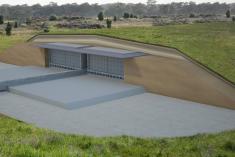In the safety file regarding the surface disposal facility, we considered conventional reinforced concrete as the reference material for manufacturing the caissons that will contain low- and intermediate-level short-lived radioactive waste. But because reinforced concrete is so sensitive to corrosion, we wouldn’t be able to dispose of waste with a high concentration of chlorides.

We subsequently launched a study into the use of fibre-reinforced concrete, as it offers a number of advantages, including greater resistance to corrosion. An update from Erik Coppens, one of our concrete specialists.
Why is concrete an essential part of the future disposal facility?
Erik: “The drums containing radioactive waste destined for the future surface disposal facility will be encapsulated with mortar in concrete caissons. This will result in so-called “monoliths” that will then be transported to the disposal site, where they will be placed in concrete bunkers (or “modules”). Thanks to their favourable properties, concrete and mortar will isolate waste and confine radioactive substances. These are two of the most important aspects of the facility's safety.”
What is fibre-reinforced concrete?

Erik: “Fibre-reinforced concrete is manufactured according to a specific formula, by homogeneous incorporation of fibres. This is an improved concrete, reinforced thanks to these fibres, which are generally made of steel. Conventional reinforced concrete, by contrast, is only reinforced with rebars. Many concrete structures use a hybrid solution: reinforced concrete and fibre-reinforced concrete, because fibres reduce the amount of rebars required. However, for the caissons of the surface disposal facility, we are currently opting for a fully fibre-reinforced concrete using stainless steel fibres. That being said, we do not rule out the possibility of adding a very limited number of rebars if this proves necessary.”
Why did you launch an RD&D programme on fibre-reinforced concrete?
Erik: “In an aggressive environment, such as waste with a high concentration of chlorides, the rebars of reinforced concrete tend to corrode over time. This corrosion eventually leads to cracks in the concrete, which could compromise the safety of the facility. This is one of the reasons why low- and intermediate-level short-lived waste with a high concentration of chlorides cannot currently be disposed of in the future surface repository.
To optimise the disposal facility, we launched a research and demonstration programme which confirmed that the use of fibre-reinforced concrete offers a number of advantages. Firstly, in terms of durability and safety: fibre-reinforced concrete offers greater resistance to corrosion. The tests show that the effects of corrosion on fibre-reinforced concrete are slower and, above all, less invasive than on reinforced concrete. Reinforced concrete eventually cracks under the effect of corrosion and crumbles, which can in turn exacerbate the effects of corrosion.
Fibre-reinforced concrete also offers safety advantages: it does not require the manufacture of a reinforcing rebar cage, which reduces the risk of errors and accidents during manufacture, and cuts costs.”
Laboratory and caisson plant tests
Erik: "Several fibre-reinforced concrete compositions were designed and laboratory tested before we eventually arrived at the ideal composition. Laboratory tests have confirmed the mechanical strength of the composition we have chosen and provided an initial insight into its application. This composition was then tested on site, in the plant that will manufacture the caissons. More tests are still in progress. However, initial results show that the strength of fibre-reinforced concrete produced on site and in the laboratory is comparable. They also demonstrated the workability of this material for manufacturing the caissons.”

Optimised production
Erik: "As a result of this research, we were able to optimise the production method for the caissons. To increase production quality, we tested several processes using the Design of Experiments (DoE) method to quantify the effect of different production parameters. We continue to monitor the manufacture of prototype caissons to ensure further optimisation.
If, in the end, we opt for fibre-reinforced concrete, we will have to adapt the safety file for the disposal facility accordingly and have it validated by the Federal Agency for Nuclear Control (FANC). Industrialisation of the manufacturing process is planned for the medium term.”
